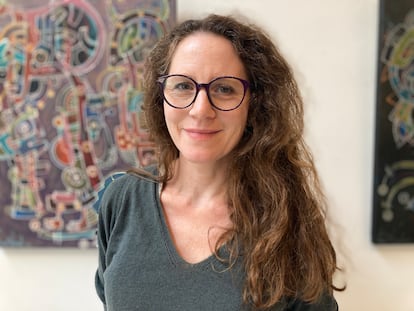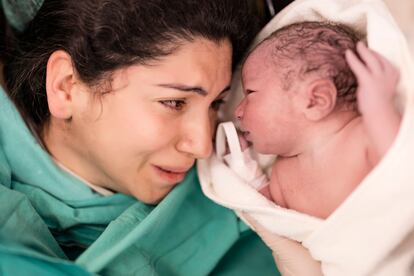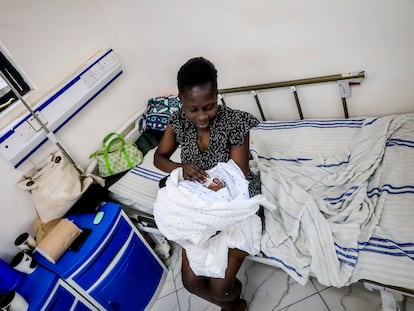Michelle Sadler, medical anthropologist: ‘The system puts so many barriers in the way of profound change in childbirth care’
The activist against obstetric violence has spent more than two decades researching birth and labor. Also an author, she advocates for transforming the way we care for women during labor, and proposes normalizing models like home birth and midwife-led centers

Michelle Sadler (Santiago, Chile, 49 years old) is a medical anthropologist. She has formed part of the Latin American and Caribbean Network for the Humanization of Labor and Birth (RELACAHUPAN), and currently directs the Observatory of Obstetric Violence in Chile (OVO Chile). She has been an activist and researcher in the field of childbirth for 25 years, and has been interested in the subject since she was young, which became clear when she began to fill her notebooks with drawings of wombs and babies. It wasn’t until college that she was able to attend a birth for the first time. She did so as an anthropology student, thanks to a professor’s permission.
“I wanted to see births, as I was deeply intrigued to know the details of how we are born,” she says in an interview with EL PAÍS in Madrid, during a visit to give a lecture. Based on her research in Santiago hospitals, and a four-year study focusing on labor and birth, she published her thesis Así me nacieron a mi hija (That’s how my daughter was born to me): anthropological contributions to the analysis of hospital childbirth care (2004). Since then, the author of the Spanish language book La historia ilustrada de un embarazo (Illustrated history of a pregnancy) (Editorial Catalonia, 2017) has carried out numerous studies, formal as well as informal, and has published a range of articles on questions surrounding obstetric violence, labor and experiences of motherhood.
QUESTION. What was it like to witness labor for the first time?
ANSWER. What I found was a common area where there were many women in various stages of labor, lying on their backs on stretchers, connected to fetal monitors, who were not allowed to move or wander around. They were frightened, expressing that they were in pain, but receiving comments that dismissed their discomfort or underestimated their fears: “It can’t hurt that much”, “Don’t be a complainer”, “What could you need if everyone here is just like you, and they don’t complain that much!”
Q. What came to mind at that moment?
A. I was shocked to witness normalized interactions in which midwives and obstetricians ignored women’s feelings, used derogatory language, while the professionals focused on monitors and charts, rather than the women themselves. I did not understand how these behaviors were so normalized. Since the beginning, my goal was to try to show people what I was seeing, but what others seemed not to see. That brought me to question how to present this information, and how I could appeal to the system from my position as an anthropologist.
Q. This happened at the end of the 20th century?
A. Yes, at that time there had begun to be a lot of concern over all this that many authors had already been thinking about for years. In 2000, in Fortaleza, Brazil, the First International Conference on the Humanization of Childbirth was held and RELACAHUPAN was founded. That event, which was a milestone in that region, was attended by thousands of people, including prominent professionals from various disciplines and women and mothers who were interested in these issues. There, I met Marsden Wagner, the former director of the World Health Organization’s maternal and child health program, and was able to begin a conversation with him about my desire to challenge the medical system. Wagner told me: “If you want to do this, you have to use the language of the system.” That conversation was a turning point for me and opened a path towards a lot of study and research.
Q. Have you been able to appropriate that language so they listen to you?
A. Perhaps more than appropriate, I’ve attempted to understand it, learn when it comes from and how it came to construct such a representation of women and childbirth. But it has not been easy, the role of researcher-activist is often discredited. And during the first years, despite having observed hundreds of births, doing qualitative research — which analyzed the experiences of mothers and the professionals who attended them — what I received were comments that this violence was not the norm, that it was the exception and that these cases were not representative. In the face of resistance, and after founding the Obstetric Violence Observatory, we conducted quantitative research with larger samples to demonstrate the extent of the problem, and with that, we got more attention from the medical sector.
Q. Is the qualitative also important?
A. The qualitative is essential, it allows us to show lived, felt experiences in the first person. The classic indicators in maternal health may seem to be very good, such as the low maternal and neonatal mortality rate, but women may be living negative and even traumatic experiences of childbirth, which is not reflected in these indicators. That is why qualitative methods allow us to center those voices, to look at human rights, reproductive rights, gender violence, and to name abuses. I remember a conference in which I presented in front of many obstetricians, and in which a very confused doctor told me that he had never, in his 40 years of professional practice, seen a situation of violence against a woman like the ones I was describing. I told him that it was difficult to believe that he had never seen them, but rather that he had not recognized them as such. This way of attending to labor is so normalized, the refusal to listening to women, treating her like an object, not valuing her feelings, not looking at her, that we don’t see it as a form of abuse.

Q. Is that changing?
A. I think there are more and more professionals who recognize obstetric violence. In a gathering like that one, I don’t think that would happen anymore. Nowadays there is more awareness, more recognition. It’s true that more traditional professional organizations are still very rigid when it comes to these issues, and do not recognize the concept of obstetric violence. However, at the same time, new, younger, gender-aware organizations have appeared that challenge the more traditional sector.
Q. Do you think that use of the term “obstetric violence” is important?
A. Naming obstetric violence as a specific kind of violence has been crucial in the movement for childbirth rights. I think the act of naming something is a very potent act when it comes to provoking a reaction. It’s true that many people do not recognize the term, because it’s very intense to recognize that you are exercising violence, but we have to call it what it is. A woman who is immobilized in the middle of childbirth, in the lithotomy position, who complains, and is ignored as if she didn’t exist, or has her pain minimized, is being subjected to violence. I believe that we must go beyond the binary of good guys and bad guys, victims and executioners, and take responsibility for the structure. The system exercises violence towards health professionals as well.
Q. Who is responsible for this change?
A. It has been women, associations, civil society, who have led the demand for change. But progress is slow; it takes a lot of work to change the medical paradigm. Childbirth, in most cases, is a normal event that should not have complications. However, we have been led to believe the opposite: that it is inherently pathological, that it is very complicated, that it needs certain interventions … When we are told that we are going to have an intervention — an episiotomy or an improper use of synthetic Oxycotin, for example — we often accept it, because we trust that it is necessary. That is why it is important that we question the decision-making process and the information we receive about childbirth. Most of the time, this information is not based on scientific evidence, but rather on the organizational and financial convenience of the health system. Fear of childbirth is encouraged, because we conform to that system and to those needs that transcend evidence or what is best for women and babies.
Q. What would be an interesting direction to go in?
A. I think we have to change the space in which labor takes place, and that hospitals should be used for deliveries that really require medical intervention, but not all of them. We have seen that it is very difficult to change the way care is provided inside hospitals, which have their protocols, power structures, economic incentives … The system puts so many barriers in the way of profound change in childbirth care. If you take childbirth out of this structure, to another space, the change is made more easily; and that is why the models of home birth and midwife-led birth centers are good alternatives.
Sign up for our weekly newsletter to get more English-language news coverage from EL PAÍS USA Edition
Tu suscripción se está usando en otro dispositivo
¿Quieres añadir otro usuario a tu suscripción?
Si continúas leyendo en este dispositivo, no se podrá leer en el otro.
FlechaTu suscripción se está usando en otro dispositivo y solo puedes acceder a EL PAÍS desde un dispositivo a la vez.
Si quieres compartir tu cuenta, cambia tu suscripción a la modalidad Premium, así podrás añadir otro usuario. Cada uno accederá con su propia cuenta de email, lo que os permitirá personalizar vuestra experiencia en EL PAÍS.
¿Tienes una suscripción de empresa? Accede aquí para contratar más cuentas.
En el caso de no saber quién está usando tu cuenta, te recomendamos cambiar tu contraseña aquí.
Si decides continuar compartiendo tu cuenta, este mensaje se mostrará en tu dispositivo y en el de la otra persona que está usando tu cuenta de forma indefinida, afectando a tu experiencia de lectura. Puedes consultar aquí los términos y condiciones de la suscripción digital.
More information
Últimas noticias
Welcome to the post-religion era: The idea of Christianity as the absolute truth has become obsolete
‘I thought you would like it’: The risky sexual practice popularized by TV shows and TikTok
The digitalization of tourism: ‘They promise experiences and gave us the worst possible one’
Mexican peso defies uncertainty with forecasts of a new period of stability in 2026
Most viewed
- Sinaloa Cartel war is taking its toll on Los Chapitos
- Oona Chaplin: ‘I told James Cameron that I was living in a treehouse and starting a permaculture project with a friend’
- Reinhard Genzel, Nobel laureate in physics: ‘One-minute videos will never give you the truth’
- Why the price of coffee has skyrocketed: from Brazilian plantations to specialty coffee houses
- Silver prices are going crazy: This is what’s fueling the rally











































